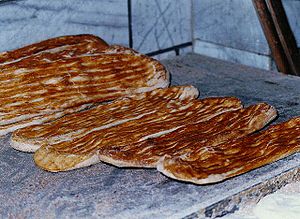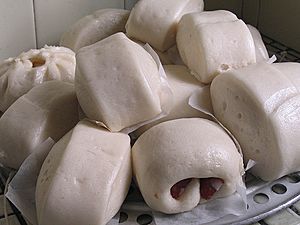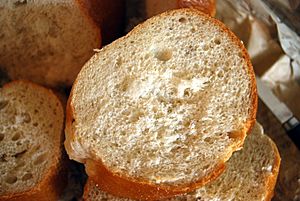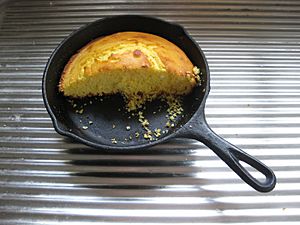Bread in culture facts for kids

Bread is more than just food in many parts of the world, especially in Western countries and Asia. It has a long history and is still very important today. For example, in Christianity, bread is a key part of the Eucharist ceremony, along with wine. The word companion even comes from Latin words meaning "with bread"!
Bread has also played a big role in politics. In 19th-century Britain, the high price of bread caused many arguments and disagreements. People debated about free trade versus protectionism. Hundreds of years ago, in the 13th century, a law called the Assize of Bread and Ale showed how important bread was. It set out strict punishments for bakers who cheated their customers. Bread was even mentioned in the famous Magna Carta document!
Sometimes, the type of bread someone buys can show things about them. Buying expensive bread might suggest someone has a lot of money. Or, choosing a type of bread that is thought to be very healthy can show that someone cares about their health.
... bread has become an article of food of the first necessity; and properly so, for it constitutes of itself a complete life-sustainer, the gluten, starch, and sugar, which it contains, represents azotised and hydro-carbonated nutrients, and combining the sustaining powers of the animal and vegetable kingdoms in one product. Mrs Beeton (1861)
Bread is simple, cheap, and can be used in many ways. Because of this, in some languages like Greek and Punjabi, the word for bread is sometimes used to mean food in general. There are so many different kinds of bread around the world! Think of bagels, baguettes, biscuits, chapatis, naan, pitas, pizza, and tortillas. Many countries also have their own types of "cheese bread", like in Brazil and Italy.
Contents
Bread Around the World
Bread in Asia
In Iran, some of the most popular breads are Sangak, barbari, taftoon, and lavash. Iranian breads come in many different shapes, sizes, and flavors.
The traditional bread in China is mantou. It's made by steaming or deep-frying dough from wheat flour. In northern China, mantou is often eaten instead of rice. Steamed mantou is like white bread but doesn't have a brown crust because it's not baked. If mantou has a filling, like meat or vegetables, it's called baozi.
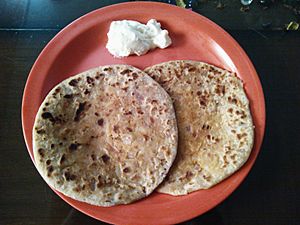
In the Indian subcontinent, chapati or roti are very common. These are flatbreads made from wheat flour and cooked on a hot griddle. Rotis and naans are often eaten with curry. A type called makki di roti uses maize flour. puri is a thin flatbread that is fried and puffs up. Paratha is another kind of roti. Naan is a leavened bread baked in a clay oven called a tandoor.
In the Philippines, pandesal is a round bread often eaten for breakfast. Its name means "bread of salt."
Bread in Europe
Europe has a huge variety of breads. Germany alone has over 1,300 types of breads and rolls! Germany also eats the most bread per person in the world. In many parts of Central and Eastern Europe, offering Bread and salt is a way to welcome guests.
In France, fewer people are eating baguettes than before. In the 1970s, French people ate about one loaf of bread per day. Now, it's only about half a loaf. Bakers have started a campaign to encourage people to buy bread more often, just like they used to.
In the 18th century, bread was super important in France. People believed that wheat bread was essential for good health. They wanted their bread to be pure, without other flours mixed in. Bread was the main part of every meal, and other foods were seen as less important.
Great Britain has many traditional breads, often baked in rectangular tins. There are also round loaves like the stottie cake. A cottage loaf is made of two balls of dough stacked on top of each other. There are also many types of bread rolls, like baps and barms.
In Spain, the traditional bread is a long loaf, like a French baguette but wider. You can buy it fresh every morning from bakeries. A smaller version is called a bocadillo. Bakers in Spain have had guilds (groups) for over 750 years!
Turkey eats the most bread per person in the world, followed by Serbia and Bulgaria.
Bread in Latin America
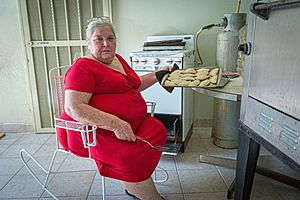
Flatbreads are common across Latin America, with sopaipillas being very popular. Chile is the second-largest consumer of bread per person worldwide.
In most of Mexico, corn tortillas are the main bread. But bread rolls are also a big part of daily food in cities. Popular Mexican breads include the bolillo roll and pan dulce (sweet bread), which is often eaten with hot chocolate in the evenings.
Chapati breads are also common in the Caribbean Islands and Guiana.
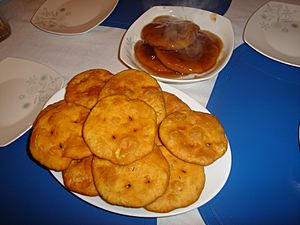
Peru has many kinds of bread. People often eat pan de piso and pan serrano. Some breads are even made from potatoes! Bizcochos are sweet breads eaten with butter and hot chocolate.
In Venezuela and Colombia, arepa is a common bread made from corn flour. Arepas are often filled to make sandwiches.
Many breads in Paraguay, Brazil, and Northeast Argentina are made with flour and cheese, like chipa and pão de queijo.
Bread in North Africa and Horn of Africa
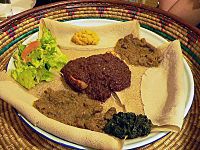
In Ethiopia and Eritrea, a bread called injera is made from a grain called teff. It's a wide, flat, round bread, similar to a tortilla, and is even used to pick up food!
In Egypt, bread is called aysh. An old saying goes, "life without aysh is not life." Egyptian bread is usually round, about 6 inches across, and often bought warm from local bakeries.
Bread in North America
Traditional breads in the United States include cornbreads and quick breads like biscuits. Rolls made from wheat flour and yeast are also popular.
Cornbread tastes and feels different depending on the region. In the Southern US, people prefer white cornmeal with little or no wheat flour or sugar. It's often baked in a cast-iron pan and has a crunchy outside and moist inside. In the Northern US, yellow cornmeal is common, sometimes with wheat flour and sweeteners like sugar or honey. This makes the bread softer and sweeter.
Spoonbread, also called batter bread, is made from cornmeal mixed with milk, eggs, and other ingredients. It's so soft it needs to be served with a spoon. This is popular mainly in the South.
Sourdough biscuits are a traditional "cowboy food" in the Western US. The San Francisco Bay Area is famous for its crusty sourdough.
Until the 1900s, wheat flour was a luxury. This is why there are more types of cornbread than wheat breads from that time. Today, the most popular bread is a soft, thin-crusted type, often sold pre-sliced. Some people call very soft bread, like Wonder Bread, "balloon bread."
While white "sandwich bread" is most popular, Americans are starting to like more unique, handmade breads. Different regions have their own special breads, like the bagel (Jewish), the French baguette, and Native American frybread.
Bread and Religion

Bread in Judaism and Christianity
Bread plays a special role in the Abrahamic religions of Judaism and Christianity.
During the Jewish festival of Passover, people eat only unleavened bread (bread made without yeast), called matzo. This remembers the time when the Israelites left slavery in Egypt so quickly that their bread didn't have time to rise. Challah is another traditional Jewish bread eaten on Shabbat and holidays.
In the Christian ceremony of the Eucharist, bread is eaten as a sacrament. For some, it's a symbol of Jesus's body. For others, like in the Catholic liturgy, it's believed to be the actual body of Christ. How the bread is made and used can be different in various Christian groups.
Bread in Other Beliefs
Some traditions of Wicca and Neo-Paganism also eat bread as part of their religious ceremonies. They give different meanings to this act.
Why Do Some People Avoid Bread?
Over time, some people have decided to avoid bread, or certain types of bread, because they thought it was unhealthy. For example, some criticized whole grain bread for being "unrefined," while others thought white bread was too "processed." Some even worried about homemade bread being unsanitary, or factory-made bread having hidden ingredients.
In the United States, bread sales dropped by about 11% between 2008 and 2013. This might be because people started getting their carbohydrates from other foods, or because of changing diet trends.
Bread in Medicine
Long ago, the ancient Egyptians used moldy bread to treat infections from dirty burn wounds. In the early 1900s, penicillin, a very important antibiotic, was discovered from molds growing on bread.


